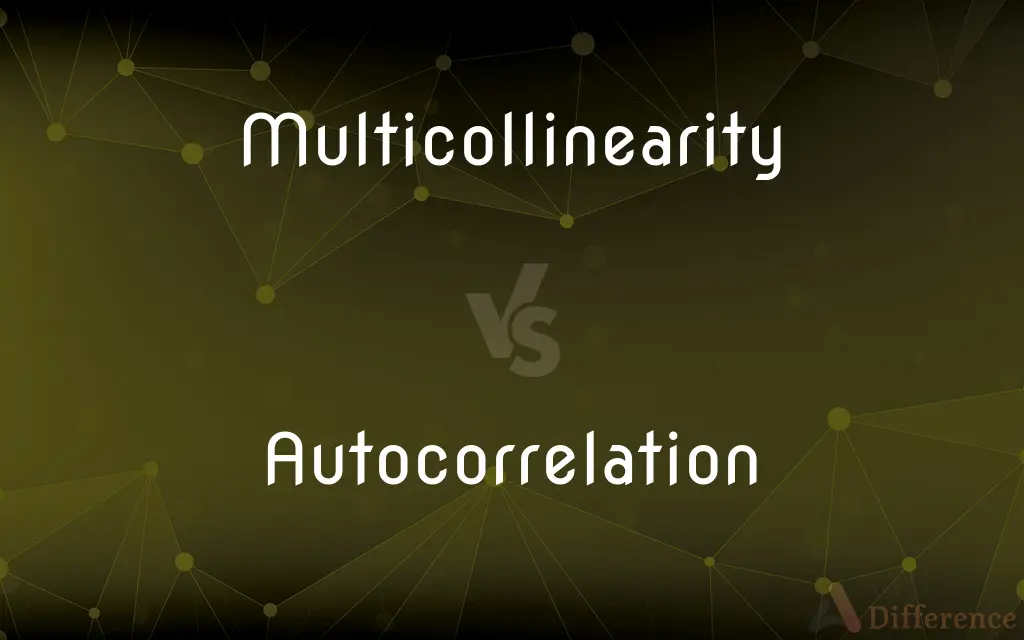Multicollinearity vs. Autocorrelation — What's the Difference?
Edited by Tayyaba Rehman — By Maham Liaqat — Updated on April 2, 2024
Multicollinearity involves high correlation among independent variables in a model, complicating the assessment of their individual effects, whereas autocorrelation refers to the correlation of a variable with itself over successive time intervals.

Difference Between Multicollinearity and Autocorrelation
Table of Contents
ADVERTISEMENT
Key Differences
Multicollinearity occurs when two or more independent variables in a regression model are highly correlated, making it difficult to isolate the effect of each variable on the dependent variable. This condition can lead to unreliable and unstable estimates of the regression coefficients, potentially skewing the model's predictions. It's particularly problematic in models where the goal is to understand the impact of each independent variable. On the other hand, autocorrelation, also known as serial correlation, happens when a variable in a time series is correlated with its own past or future values. This phenomenon is common in time series data, such as stock prices or temperature readings, where the value at any given time is likely to be similar to its value in the immediate past or future.
Multicollinearity is primarily a concern in the context of linear regression models where the clarity of the relationship between independent variables and the dependent variable is crucial. It complicates the interpretation of the coefficients, as it becomes challenging to discern how changes in one independent variable affect the dependent variable while holding others constant. Conversely, autocorrelation affects the assumption of independence in time series analyses and can lead to misleading statistical inferences if not addressed, as standard errors of the estimates may be underestimated, giving a false sense of confidence in the model's predictions.
Detecting multicollinearity typically involves looking at correlation matrices or calculating variance inflation factors (VIF) for the independent variables. High VIF values indicate a high degree of multicollinearity. Addressing multicollinearity might involve removing or combining correlated variables or applying regularization techniques. Autocorrelation, however, is detected using plots (like correlograms) or statistical tests (such as the Durbin-Watson test). Techniques to manage autocorrelation include differencing the data, using autoregressive terms in the model, or applying more complex models designed for time series data, such as ARIMA models.
While multicollinearity is a structural issue within the set of independent variables, autocorrelation is a pattern in the error terms or the dependent variable over time. Both issues, if unaddressed, can undermine the reliability and validity of a statistical model’s output. However, their implications and the strategies for dealing with them differ, underscoring the importance of diagnostic testing in the model-building process.
In practical terms, a researcher might be concerned about multicollinearity when developing a predictive model to understand how different demographic factors affect purchasing behavior. Each factor (e.g., age, income, education level) should independently explain a part of the purchasing behavior without being overly interdependent. Alternatively, a researcher analyzing monthly sales data to forecast future sales would be more concerned about autocorrelation, as sales in one month are likely to be correlated with sales in previous months.
ADVERTISEMENT
Comparison Chart
Definition
High correlation among independent variables
Correlation of a variable with its past or future values
Main Concern
Stability and interpretation of regression coefficients
Independence assumption in time series analysis
Impact
Complicates the assessment of individual variable effects
Leads to misleading statistical inferences
Detection Methods
Correlation matrices, Variance Inflation Factor (VIF)
Correlograms, Durbin-Watson test
Addressing Strategies
Remove or combine variables, regularization techniques
Differencing data, including autoregressive terms
Affected Models
Linear regression and similar models
Time series models, e.g., ARIMA
Compare with Definitions
Multicollinearity
High inter-correlation among predictors.
In real estate pricing models, square footage and number of bedrooms are often multicollinear.
Autocorrelation
Correlation of a series with its lags.
In financial markets, today's stock price is often autocorrelated with yesterday's.
Multicollinearity
Leads to coefficient instability.
High multicollinearity made it hard to assess the impact of advertising spend on sales.
Autocorrelation
Can bias statistical tests.
Autocorrelation in temperature data led to underestimating the variance in climate models.
Multicollinearity
Addressed by variable reduction.
Combining highly correlated variables reduced multicollinearity in the model.
Autocorrelation
Affects time series forecasting.
Autocorrelation was considered when forecasting electricity demand to improve prediction accuracy.
Multicollinearity
Affects regression analysis.
Multicollinearity in the regression model obscured the effects of individual predictors on house prices.
Autocorrelation
Detected by Durbin-Watson test.
The Durbin-Watson test indicated significant autocorrelation in the time series.
Multicollinearity
Detected by VIF.
A VIF greater than 5 suggests multicollinearity among variables.
Autocorrelation
Addressed with ARIMA models.
Using an ARIMA model helped account for autocorrelation in monthly sales data.
Multicollinearity
In statistics, multicollinearity (also collinearity) is a phenomenon in which one predictor variable in a multiple regression model can be linearly predicted from the others with a substantial degree of accuracy. In this situation, the coefficient estimates of the multiple regression may change erratically in response to small changes in the model or the data.
Autocorrelation
Autocorrelation, sometimes known as serial correlation in the discrete time case, is the correlation of a signal with a delayed copy of itself as a function of delay. Informally, it is the similarity between observations as a function of the time lag between them.
Multicollinearity
(statistics) A phenomenon in which two or more predictor variables in a multiple regression model are highly correlated, so that the coefficient estimates may change erratically in response to small changes in the model or data.
Autocorrelation
The cross-correlation of a signal with itself: the correlation between values of a signal in successive time periods.
Multicollinearity
A case of multiple regression in which the predictor variables are themselves highly correlated
Common Curiosities
Why is autocorrelation a problem?
Autocorrelation violates the assumption of independence in time series analyses, potentially leading to incorrect estimates of model parameters and misleading inferences about the significance of predictors.
What causes multicollinearity?
Multicollinearity is caused by a high degree of overlap or similarity in the information that independent variables provide in a regression model, often due to natural relationships between variables or poor study design.
What are the consequences of ignoring autocorrelation in a model?
Ignoring autocorrelation can result in underestimating the standard errors of regression coefficients, leading to overly optimistic conclusions about the significance of variables.
Can multicollinearity and autocorrelation occur together?
Yes, both issues can occur in the same dataset, especially in complex models involving time series data with multiple predictors, each requiring separate diagnostic tests and remedies.
What is the difference between positive and negative autocorrelation?
Positive autocorrelation occurs when an increase in a variable's value at one time point is followed by an increase at a subsequent time point. Negative autocorrelation occurs when an increase is followed by a decrease, and vice versa. Positive autocorrelation is more common in economic and financial time series, while negative autocorrelation is less frequently observed.
How can you detect multicollinearity?
Multicollinearity can be detected using correlation matrices to identify highly correlated variables or calculating the Variance Inflation Factor (VIF) for each predictor.
How can multicollinearity affect the interpretation of regression coefficients?
Multicollinearity can make it difficult to interpret regression coefficients accurately because it inflates the standard errors of the coefficients. This can lead to statistically insignificant estimates of coefficients that are actually important, misleading about the true relationship between the independent variables and the dependent variable.
How does multicollinearity affect the predictive power of a model?
Multicollinearity does not necessarily reduce the predictive power of a model as a whole; it primarily affects the reliability and interpretation of individual coefficient estimates. A model can still have high predictive accuracy even if multicollinearity is present among the independent variables. However, it complicates understanding which variables are driving the prediction.
Can autocorrelation be beneficial in any scenario?
Yes, autocorrelation can be beneficial in forecasting models, where the goal is to predict future values of a time series based on its past values. If a time series exhibits significant autocorrelation, it implies that past values can be useful in forecasting future values, making models like ARIMA particularly effective.
What strategies can be used to address autocorrelation in time series analysis?
To address autocorrelation, analysts can use techniques such as differencing the series, transforming the data (e.g., logarithmic transformation), or modeling the autocorrelation directly using autoregressive (AR) terms, moving average (MA) terms, or a combination of both in ARIMA models. These methods help in making the series stationary, a prerequisite for many time series forecasting techniques.
Share Your Discovery

Previous Comparison
Abord vs. Aboard
Next Comparison
Beforehand vs. BeforeAuthor Spotlight
Written by
Maham LiaqatEdited by
Tayyaba RehmanTayyaba Rehman is a distinguished writer, currently serving as a primary contributor to askdifference.com. As a researcher in semantics and etymology, Tayyaba's passion for the complexity of languages and their distinctions has found a perfect home on the platform. Tayyaba delves into the intricacies of language, distinguishing between commonly confused words and phrases, thereby providing clarity for readers worldwide.
















































